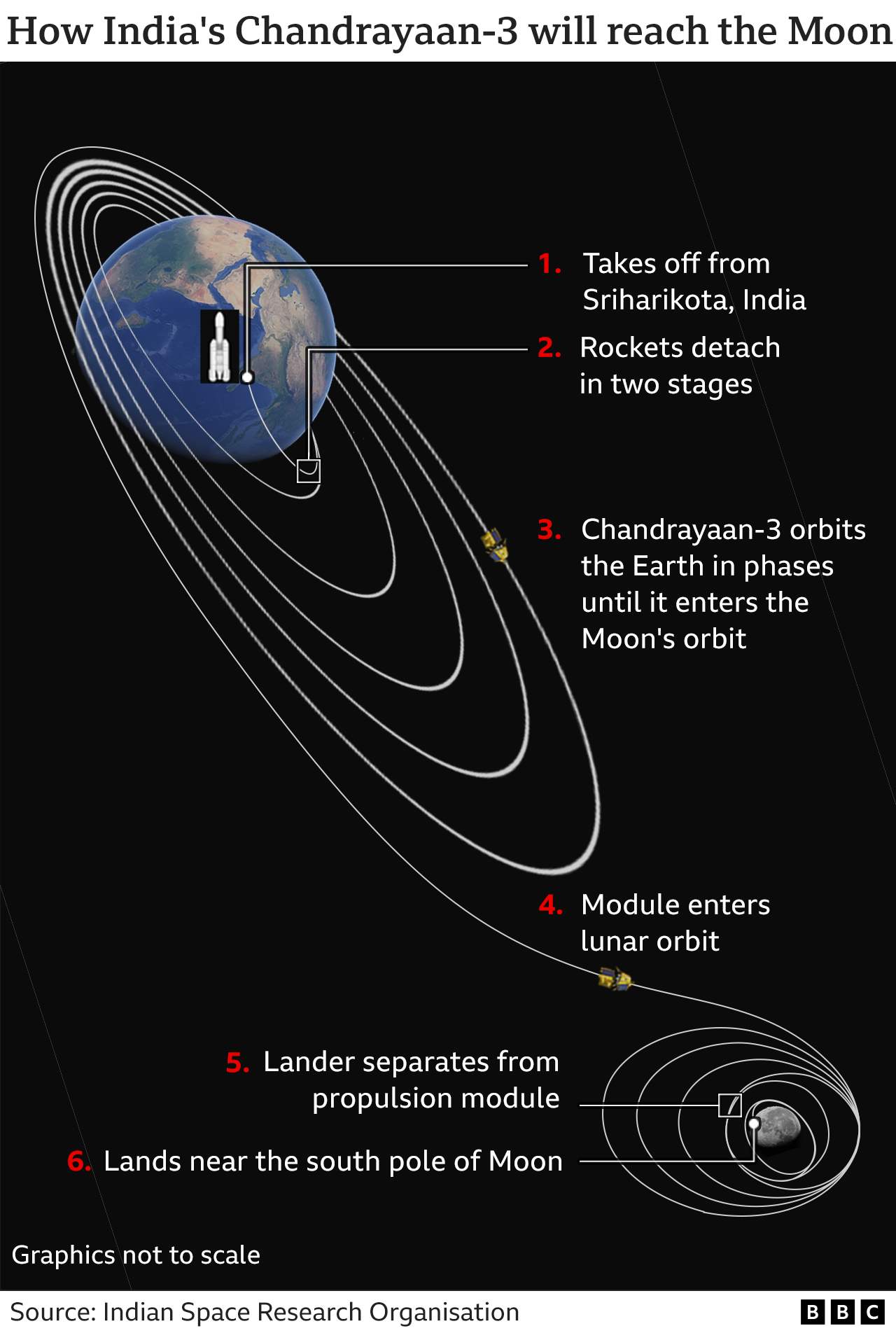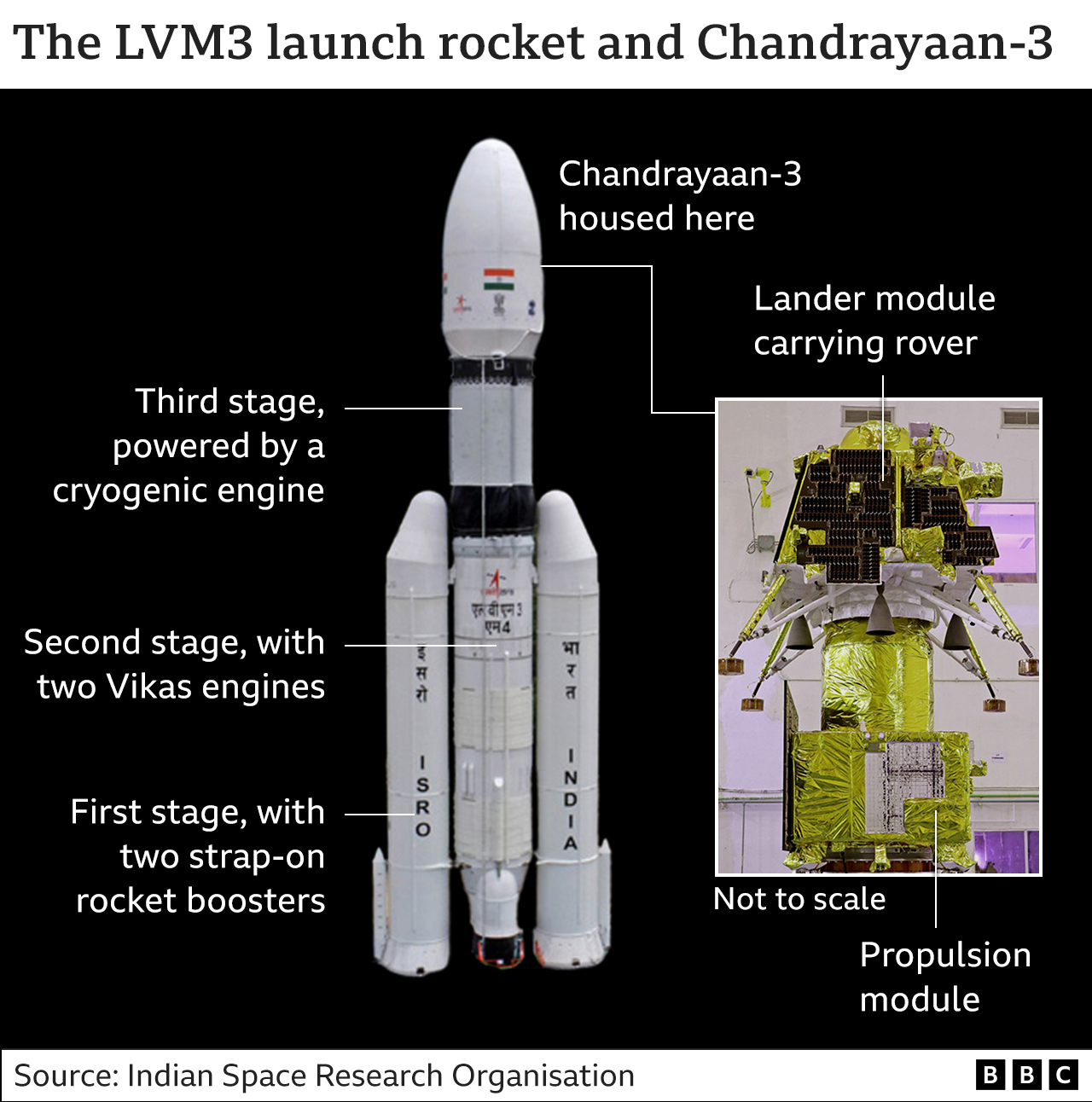India's space agency has released the first images of the Moon taken by the Chandrayaan-3 spacecraft, which entered the lunar orbit on Saturday.
The images show the craters on the lunar surface getting larger and larger as the spacecraft draws closer.
Chandrayaan-3 with an orbiter, lander and a rover is due to land on the Moon's surface on 23 August.
If successful, India will be the first country to land near the Moon's little-explored south pole.
It will also become only the fourth to achieve a soft landing on the Moon after the US, the former Soviet Union and China.
After the spacecraft orbited the Earth for about 10 days, it was sent into the translunar orbit last Tuesday and successfully injected into the lunar orbit on Saturday.
- India mission enters Moon orbit, aiming for south pole
Indian Space Research Agency (Isro) says in a press release that it has been monitoring Chandrayaan-3's "health" and that it's "normal".
It has also pointed out that "this is the third time in succession that Isro has successfully injected a spacecraft into the lunar orbit".
Scientists say Chandrayaan-3, the third in India's programme of lunar exploration, is expected to build on the success of its earlier Moon missions.
- Historic India Moon mission lifts off successfully
It comes 13 years after the country's first Moon mission in 2008, which discovered the presence of water molecules on the parched lunar surface and established that the Moon has an atmosphere during daytime.
Chandrayaan-2 – which also comprised an orbiter, a lander and a rover – was launched in July 2019 but it was only partially successful. Its orbiter continues to circle and study the Moon even today, but the lander-rover failed to make a soft landing and crashed during touchdown.

![]()
Indian Space Research Organisation (Isro) chief Sreedhara Panicker Somanath has said they have carefully studied the data from its crash and carried out simulation exercises to fix the glitches in Chandrayaan-3, which weighs 3,900kg and cost 6.1bn rupees ($75m; £58m).
The lander (called Vikram, after the founder of Isro) weighs about 1,500kg and carries within its belly the 26kg rover which is named Pragyaan, the Sanskrit word for wisdom.
- Was India's Moon mission actually a success?
- The women scientists who took India into space
Now that the craft has entered the Moon's orbit, scientists will begin reducing the rocket's speed gradually to bring it to a point which will allow a soft landing for Vikram.
"A series of manoeuvres have been planned to gradually reduce the spacecraft's orbit and position it over the lunar poles," says Isro.
"After some manoeuvres, the propulsion module will separate from the lander while in orbit. Then a series of complex braking manoeuvres will be executed to facilitate a soft landing in the South Pole region of the Moon on 23 August," it adds.
Once it lands, the six-wheeled rover will eject and roam around the rocks and craters on the Moon's surface, gathering crucial data and images to be sent back to Earth for analysis.
This video can not be played
To play this video you need to enable JavaScript in your browser.
Media caption,
Watch: The moment India launched historic Moon mission
"The rover is carrying five instruments which will focus on finding out about the physical characteristics of the surface of the Moon, the atmosphere close to the surface and the tectonic activity to study what goes on below the surface. I'm hoping we'll find something new," Mr Somanath has said.
The south pole of the Moon is still largely unexplored – the surface area that remains in shadow there is much larger than that of the Moon's north pole, and scientists say it means there is a possibility of water in areas that are permanently shadowed.
India is not the only country with an eye on the Moon – there's a growing global interest in it. And scientists say there is still much to understand about the Moon that's often described as a gateway to deep space.

![]()
BBC News India is now on YouTube. Click here to subscribe and watch our documentaries, explainers and features.
![]()
Read more India stories from the BBC:
- Common personal law proposal sparks fear in India tribes
- Did India let down the maharajahs?
- Pakistan will send team to India for World Cup
- Is India's cheetah reintroduction effort in crisis?
- The wanted cow vigilante who's at large online
![]()
